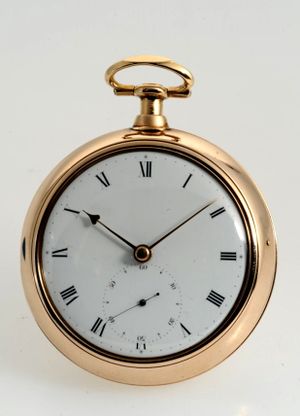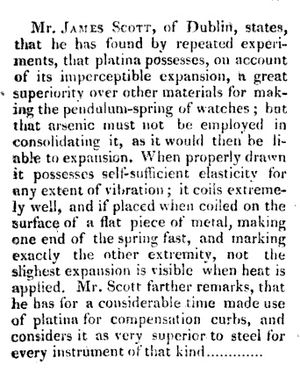Scott, James (4): Unterschied zwischen den Versionen
Zur Navigation springen
Zur Suche springen
Keine Bearbeitungszusammenfassung |
Keine Bearbeitungszusammenfassung |
||
| Zeile 1: | Zeile 1: | ||
[[Datei:James Scott, Dublin, Werk Nr. 276, circa 1800 (1).jpg|thumb|James Scott, Dublin, Werk Nr. 276, circa 1800]] | [[Datei:James Scott, Dublin, Werk Nr. 276, circa 1800 (1).jpg|thumb|James Scott, Dublin, Werk Nr. 276, circa 1800]] | ||
[[Datei:James Scott, The Monthly Magazine, Volume 27, Platina Compensation Curb.jpg|thumb|James Scott, The Monthly Magazine, Volume 27, Platina Compensation Curb]] | [[Datei:James Scott, The Monthly Magazine, Volume 27, Platina Compensation Curb.jpg|thumb|James Scott, The Monthly Magazine, Volume 27, Platina Compensation Curb]] | ||
Englischer Uhrmacher | Englischer Uhrmacher | ||
Version vom 21. Dezember 2017, 18:01 Uhr


Englischer Uhrmacher
James Scott war von 1806 bis um 1820 tätig als Chronometer- und Uhrmacher in Dublin. Er war in Grafton Street 38 ansässig. Von ihm stamm die Idee, Palladium oder Platina für eine Spiralfeder zu verwenden. Er erhielt auch ein Patent am 11. Mai 1820.
Weiterführende Informationen
- Bildgalerie Uhrenmodelle James Scott
- Bildgalerie Uhrwerke James Scott
- Bildgalerie Archiv James Scott
Quelle
- G.H. Baillie "Watchmakers and Clockmakers of the World", vol. I, Edinburgh/London, 1947, Seite 287
Weblinks
- Description of a Compensation Curb.
- Google Books The Repertory of Arts, Manufactures, and Agriculture: Consisting ..., Volume 39 James Scott.
- A Journal of Natural Philosophy, Chemistry and the Arts, Description of a Compensation Curb, By Mr. James Scott.
- The Monthly Magazine, Volume 27 Platina Compensation Curb,By Mr. James Scott.